Camouflage Markings
Nyala are the most striking of antelopes and also exhibit the greatest sexual dimorphism (difference between the genders). Females are red-brown in colour and characteristically striped along the ridge of the back with up to 18 white lines.
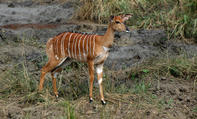
These form the animal’s camouflage breaking up their solid outline and helping them to blend into their thicket habitats. The lines are known as disruptive markings. Males are slate grey with up to 14 white stripes along the back and white spots on the flanks and belly, also disruptive markings.
The lower part of each leg is yellow in colour and contrasts strongly with the rest of the body. A shaggy white-tipped mane extends down their backs and a fringe along their under-necks and belly. Males have spiralled horns, which females lack.
The male’s coat forms a vital function in social interactions with other males and is a form of visual communication whereby bulls express their individual impressiveness and superiority.
Young Males
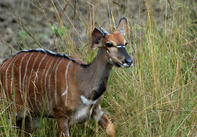
Young male nyala only begin to take on the slate-grey physical appearance of a bull from 14 months old. Up until this point the young males resemble females and are rusty-red coloured and without the mane and yellow legs.
It takes a further 10 months before the youngster assumes the full adult pelage. This may be a tactic to reduce negative attention from more mature males or possibly the tawny coat, like the females, affords the younger animals the better camouflage while they are growing up.
Associations Are Temporary
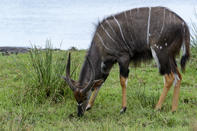
Nyala live in temporary associations whereby members of the species join up and depart from one another’s company freely every couple of hours. The only persisting bonds between nyala exist between a female and her offspring and these, including the most recent and previous calf, are usually found together in small groups.
Sometimes family groups may combine temporarily to form slightly larger groups and aggregations of between 30 and 100 individuals do form where there is a common resource such as a waterhole or a particularly good feeding site. At times such as these, all but the members of the individual family units ignore one another but they do all benefit from the collective vigilance such congregations afford.
Mature bulls tend to be solitary but will interact with female groups as they encounter them to check whether any of the females are in heat (oestrus). If they are, the male will remain with the herd and try to court the ewe. Males do not defend territories and are tolerant of one another provided there is no oestrus ewe in question.
Within a particular area, all males will fit into a local dominance hierarchy maintained by passive displays that prevents aggression when they encounter one another.
Strength Shows
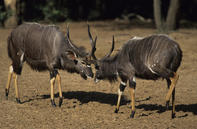
Although male nyala do not defend territories, they do exhibit a variety of status rituals even in the absence of other nyala. The males gouge up soft soil with their horns and rub their faces and horns on bushes.
They lack preorbital glands and no visible scent mark is left behind by these actions, so their function is poorly understood. Sometimes males will demonstrate their strength or vent aggression by thrashing bushes even simultaneously pawing the ground.
Visual Dominance
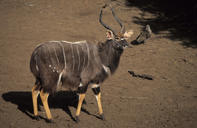
The brilliant coat of the male nyala is used in a visual dominance display known as lateral presentation. This is a passive method of determining superiority based on physical impressiveness. The winner supercedes the loser with regards to access to oestrus cows.
These displays occur at different intensities depending on the response of the contender. When two males engage in lateral presentation, the mane along the neck is raised, called pilo-erection, enhancing the size of the animal and the white of it contrasts superbly with the slate grey flanks and the yellow legs, which are lifted slowly in an exaggerated high-step walk as the contestants parade around one another, head to tail.
The tail is lifted over the rump to display its white underside and depending on the desired intensity the horns are either lowered poised to attack, high intensity, or the head is held high, moderate intensity. The animal that first becomes intimidated by his competitor’s good stature will break off and show his submissiveness by lowering his crest and tail and commencing feeding or grooming. An equal match may lead to actual contact whereby the bulls will engage head to head and push each other and clash horns sometimes savagely.
By Megan Emmett